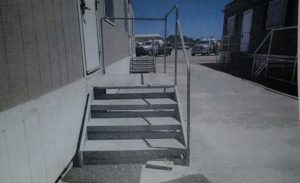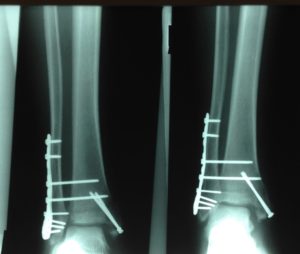Piccuta Law Group Obtains $165,000 Settlement for Client who Injured Leg While Exiting Building
Last week, the Piccuta Law Group settled a case for a client who suffered a leg injury when she fell exiting a building in Salinas, California. The injury occurred in 2018 when the client was dropping off lunch for her husband at his place of work. The client entered a portable office that had been constructed on the worksite. When she was exiting, she stepped out of the office and fell when the landing was not where she expected it to be. In doing so, the client fractured her ankle.
Our Monterey personal injury attorneys filed a lawsuit in Monterey County Superior Court. The lawsuit was entitled E. S. v. SBMD Properties, LLC, Et Al. and designated case # 20CV001299. The case was assigned to the honorable Thomas W. Wills.
The Facts Alleged by Our Monterey Personal Injury Attorneys
On April 27, 2018, the client visited a business where her husband worked. The client’s husband worked in the agriculture industry and the business was located on an open piece of property near produce fields in Salinas. The property was used to park vehicles and then agricultural workers would be transported to the fields where they worked. The property had several portable buildings erected on it that were used for various purposes including as office space.
The client entered one of the buildings to use the phone. When she attempted to exit by way of platform stairs, she expected the landing to be even with the threshold to the doorway. Instead, the landing was approximately six inches below the threshold. As her right foot searched for the landing, her momentum carried her forward until her foot contacted the landing at an awkward angle. The client’s right ankle bore her entire body weight as it rolled to the side and cracked before she plummeted down the stairs.

First responders from the Monterey County Regional Fire District arrived on the scene. The emergency care providers established an IV, administered 5 mg of morphine, splinted the client’s leg, applied ice and helped place her on a gurney and in the back of an ambulance. The client was then transported to the Natividad Medical Center Emergency Department. The ambulance records document the client’s pain level at 10 out of 10. The traumatic injury to her ankle was so severe that after the administration of morphine, her pain level diminished no further than to 7 out of 10 on a pain scale.
The Serious Personal Injuries that Resulted from the Fall
The client presented to the emergency room at Natividad Medical Center with a swollen ankle and a pain level at 8 out of 10. A physical examination of the client revealed general distress due to pain and tenderness and deformity to her right ankle. After x-rays were taken the client was diagnosed with a trimalleolar facture of the right ankle. A trimalleolar facture occurs when the three malleoli bones that make up the ankle break at the same time. These consist of the: 1) lateral malleolus, which is at the end of the fibula; 2) the medial malleolus, which is on the inside of the tibia (shinbone); and 3) the posterior malleolus, which is at the back of the tibia. The three bones are imperative for anchoring the ligaments that support control, movement and stability in the foot and ankle. These types of fractures are considered more unstable than other fractures and often lead to ligament injury and dislocation.
That same day, the client underwent a surgery with hardware to repair her injured leg. Specifically, the client underwent an open reduction internal fixation surgery to align the fractured bones in her right ankle. The surgery included the placement of a plate and screws. Holes were drilled into the client’s bone and a combination of ten locking and non-locking screws were placed in the holes and tightened to secure the plate. After the plate was fixed, the wound was closed with stitches and staples.

In the month following the surgery, the client struggled with significant and ongoing pain. At her post-surgical exam, the client showed her foot had not moved at all and that it was in equinus. A person with equinus lacks the flexibility to bring the top of the foot toward the front of the leg.
The hardware in the client’s leg caused her pain and discomfort. Eventually, the client requested that the hardware be removed. In September 2018, the client underwent a second surgery to have the hardware removed from her leg. Due to an out-of-state move, the client never participated in physical therapy for her injured ankle. Although the client’s injury had healed, the client had limitations with respect to running long distances and wearing high heel shoes.
Winning a Premises Liability Lawsuit and Proving a Trip and Fall Claim
A premises liability claim is a type of negligence claim. Essentially, the injured person is alleging that the property owner was negligent in allowing a dangerous condition on his or her property to exist. The injured person is further alleging that the dangerous condition caused he or she to suffer an injury and that he or she would not have been injured but for the dangerous condition.
A dangerous condition can be a variety of things. The dangerous condition can be something spilled on a floor, a defective step or stair, an unmaintained electrical wire, a diseased tree that falls, a cracked or displaced sidewalk section, an uncovered pool, a hole or trench, a sharp edge of a clothing fixture in a retail store, among many other things.
To prove a premises liability case, under California law, a person must prove:
- that a person or business who owed, leased, occupied or controlled a property; 2. Was negligent in the use of maintenance of that property and 3) that the negligence was a substantial factor in causing the injured party harm.
California law further holds that an “owner of a premises is under a duty to exercise ordinary care in the management of such premises in order to avoid exposing people to an unreasonable risk of harm. A failure to fulfill this duty is negligence.” Brooks v. Eugene Burger Management Corp., 215 Cal.App.3d 1611, 1619 (1989).
The property owner or occupier is negligent if he fails to use reasonable care to keep the property in a reasonably safe condition. This requires the property owner or occupier to “use reasonable care to discover unsafe conditions and to repair, replace, or give adequate warning of anything that could be reasonably expected to harm others.”
The property owner or occupier is negligent if he fails to use reasonable care to keep the property in a reasonably safe condition. This requires the property owner or occupier to “use reasonable care to discover unsafe conditions and to repair, replace, or give adequate warning of anything that could be reasonably expected to harm others.” California Civil Jury Instruction 1001.
California Jury Instruction 1001 states that a jury may consider the following when deciding whether a property owner or occupier used reasonable care:
- The location of the property
- The likelihood that someone would come on to the property in the same manner as the injured person did
- The likelihood of harm
- The probable seriousness of such harm
- Whether the injured person knew or should have known of the condition that created the risk of harm
- The difficulty of protecting against the risk of such harm
- The extent of the property owner or occupier’s control over the condition that created the risk of harm
- Any other relevant factors
The Arguments Advanced By Our Monterey Premises Liability Attorneys
In the case discussed above, our personal injury attorneys were able to discover that the building was unpermitted. We further discovered evidence that the stair landing did not comply with building codes and was never inspected. We learned later that the County had cited the owner with a code violation at the property and that the property owner decided to remove the building entirely.
Luckily, photographs of the building and the stair landing were obtained early on. The photographs showed an approximately six-inch drop from the door threshold of the building to the stair landing. We argued that the stair landing was required to be flush with the stair threshold and that the drop did not comply with the building code. As such, it was a known dangerous condition that caused the client injury and one that the property owner had a duty to correct. By doing so, we secured a sizeable settlement for the client.
Contact Our Personal Injury Law Firm today to Discuss Your Premises Liability Case
If you or a loved one was injured in a trip and fall, slip and fall or due to a dangerous condition on property, contact the Piccuta Law Group today. A skilled personal injury attorney is available now to analyze and discuss your case. A consultation by phone is free. If we agree to take your case, it will cost you nothing up front. We will only charge a fee if we recover for you and any fee we earn will come out of the settlement paid by the other side. Do not hesitate to contact us today.
About the author: The content on this page was written by California civil rights lawyer and Monterey personal injury attorney Charles “Tony” Piccuta. Piccuta graduated with honors from Indiana University-Maurer School of Law in Bloomington, Indiana (Ranked Top 35 US News & World Report 2018). Piccuta took and passed the State bars of Arizona, California, Illinois and Nevada (all on the first try). He actively practices throughout California and Arizona. He is a winning trial attorney that regularly handles serious personal injury cases and civil rights lawsuits. He has obtained six and seven figure verdicts in both state and federal court. He has been recognized by Super Lawyers for six years straight. He is AV Rated by Martindale Hubble. He is a member of the Consumer Attorneys of California, American Association for Justice, National Police Accountability Project, Arizona Association of Justice, Maricopa County Bar Association and Scottsdale Bar Association, among other organizations.
Disclaimer: The information on this web site is attorney advertising and is for informational purposes only. It does not constitute legal advice. Reading and relying upon the content on this page does not create an attorney-client relationship. If you are seeking legal advice, you should contact our law firm for a free consultation and to discuss your specific case and issues.
References:

